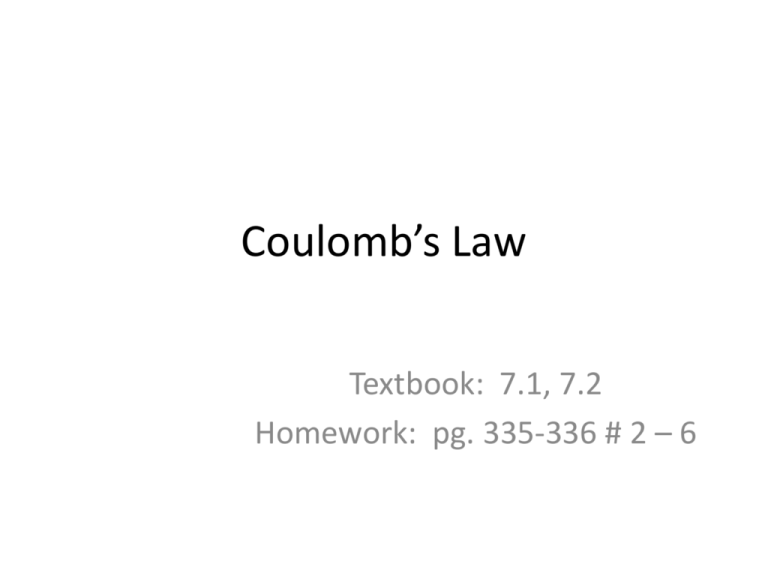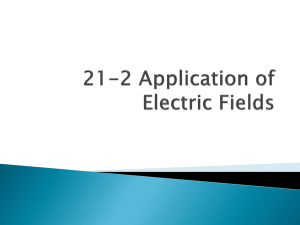Gravitational Potential Energy & Orbital Energy - Mr. Cheng
advertisement

Coulomb’s Law Textbook: 7.1, 7.2 Homework: pg. 335-336 # 2 – 6 Electrical Structure of Matter • The Law of Electric Charges: – Opposite Charges Attract – Similar Charges Repel – Charged objects attract some neutral objects • Law of Conservation of Charge: – For an isolated system the total charge is constant • Both gravity and the electrical force are “action-at-adistance” forces Coulomb’s Law Charles Augustin de Coulomb (1736 - 1806) • Two objects with charges q1 and q2 (in C) separated by a distance r (in m) experience a force of magnitude: – k = 9.0 x 109 Nm2/C2 • Compare/Contrast Coulomb’s Law to Newton’s Law of Universal Gravitation Pg 330 • 1. Two charged spheres, 10.0 cm apart, attract each other with a force of magnitude 3.0 x 10-6 N. What force results from each of the following changes, considered separately? (a) Both charges are doubled, while the distance remains the same. [1.2 x 10-5 N] (b) An uncharged, identical sphere is touched to one of the spheres and is then taken far away. [1.5 x 10-6 N] (c) The separation is increased to 30.0 cm. [3.3 x 10-7 N] • Two identical small spheres of mass ______ are fastened to the ends of an insulating thread of length ________. The spheres are given identical electric charges and hang in static equilibrium, with an angle of ________between the string halves, as shown above. Calculate the magnitude of the charge on each sphere. Coulomb’s Law (Continue) Textbook: 7.2 Homework: pg. 336 # 7 – 10 The principal of superposition • states that the resultant force is the vector sum of the forces that are coming together • Note: when finding the resultant force on a “free to move” charged object, keep all other charged objects stationary. Pg 334 # 8 • Three objects, carrying charges of -4.0 x 10–6 C, -6.0 x 10–6 C, and +9.0 x 10–6 C, are placed in a line, equally spaced from left to right by a distance of 0.50 m. Calculate the magnitude and direction of the net force acting on the first charge. (0.54 N [left]) Pg 334 # 9 • Three spheres, each with a negative charge of 4.0 x 10–6 C, are fixed at the vertices of an equilateral triangle whose sides are 0.20 m long. Calculate the magnitude and direction of the net electric force on each sphere. (6.2 N [outward, 150º away from each side]) Electric Fields Textbook: 7.3 Homework: pg. 343-344 # 1 – 7 pg. 347 # 8 – 10 Electric Fields • A field can be represented with a field diagram which follows these rules: – Field lines come out of sources (+ve charge) – Field lines go into sinks (-ve charge) – Field strength depends on line density – Field lines cannot cross Field lines: • • • • Ex. Ex. Ex. Ex. Positive charge Negative charge Positive and negative charge Capacitor • Ex. Pg. 344 #6 The electric field strength midway between a pair of oppositely charged parallel plates is 3.0 x 103 N/C. Find the magnitude of the electric field midway between this point and the positively charged plate. Electric Fields • The electric field a distance r (in m) away from a charge q1 (in C) is: – k = 9.0 x 109 Nm2/C2 Pg 343 # 1 • Two negative charges of 2.4 x 10-6 C and 4.0 x 10-6 C are placed 0.5 m apart. Where would a positive charge of 1.0 x 10-6 C be placed to have a zero net electric force/field? Illustrate using field lines. 0.22 m Pg 344 # 5 • Determine the magnitude and direction of the electric field at point Z in Figure 14, due to the charges at points X and Y. [1.2 x 105 N/C [up]] • What would happen to the uniform field strength inside a parallel-plate capacitor if the following changes were made independently of each other? – a) The distance between the plates is doubled. – b) The charge on each plate is doubled. – c) The plates are totally discharged and neutral. Electric Potential Textbook: 7.4 Homework: pg. 358 – 359 #1 – 8 Electric Potential Energy Work done is the change in the electric potential energy of the charge in an electric field. • The electric potential energy stored in a system with two charges q1 and q2, separated by a distance r is: q1q2 < 0 charges are bound q1q2 > 0 charges are unbound kq1q2 EE r Electric Potential • Electric potential energy per unit charge is referred to as electric potential or just potential. • The electric potential (V) a distance r away from a charge q is: • The change in electric potential between two points is the electric potential difference V (also know as the voltage) Important Relationships • In general • For a parallel plate (electric field, = constant) • A positive test charge of 1.5 x 10-6 C is placed in an electric field 10 cm from another charge of magnitude - 5.0 x 10-6 C that is anchored in place. a) What is the electric potential energy of the test charge? [-6.8 x 10-1 J] b) What is the potential difference between the test charge’s initial position and a point 5.0 cm closer to the negative charge? [-4.5 x 105 V]







